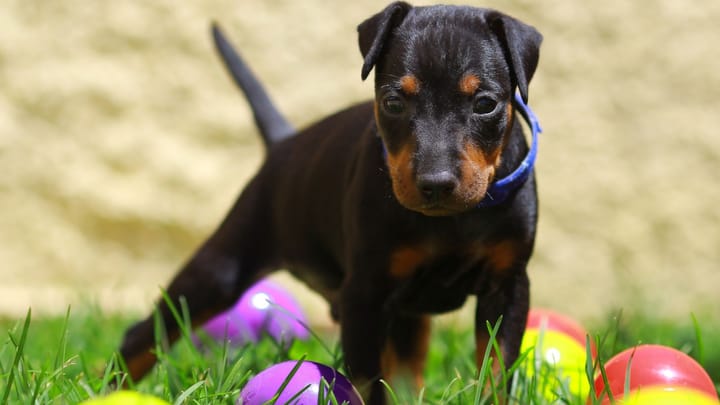Manchester Terrier


This feisty Mancunian gentleman is a very special terrier: eager, sociable, and fearless. A smartly designed little character, his glory days were those of the industrial revolution when working people and dogs alike enjoyed the dubious sport of rat-baiting in England’s engine room, the city of Manchester. The Manchester Terrier stood up against the rats, putting his rabbit-hunting instincts into an urban context. Numbers dropped following the exodus of the rats and a ban on rat-baiting, and although he has enjoyed a renaissance of late, he remains a vulnerable breed.
|
Life expectancy |
The Manchester Terrier has a life expectancy of between 14 and 16 years |
|
Temperament |
|
|
Size |
Medium
|
|
Adult size |
Female
Between 14 and 16 in
Male
Between 15 and 17 in
|
|
Adult weight |
Female
Between 15 and 18 lb
Male
Between 15 and 18 lb
|
|
Coat colour
|
Black Red |
|
Type of coat
|
Short |
|
Eye colour
|
Brown
|
|
Purchase price |
The Manchester Terrier costs between £700 and £850 |
The Victorians knew him as ‘the Gentleman’s Terrier’ because he’s such a smart looker.
More details about the Manchester Terrier
Manchester Terrier: Origins and history
The Manchester Terrier came here to do two things: chase rabbits and fight rats. As such, it is believed he was developed from a meeting of a fast breed (the whippet) and a rat-killing one (the black-and-tan terrier). While these pastimes have dwindled over the years since the Manchester Terrier’s 19th century heyday, the dog himself was too charming to forget. Although his numbers dipped significantly following WW2, breeders and enthusiasts have battled to keep the breed afloat.
Physical characteristics of the Manchester Terrier
This neat little package is all wrapped up in what the FCI lovingly calls “jet black and rich mahogany tan” fur. Indeed, there’s something at once luxurious and deeply down to earth about this scampish, tight-limbed fellow, and perhaps it is in the juxtaposition of the gem-likeness of his eyes and their mischievous edge; the Egyptian glamour of his prominent, pointy ears and their eminent practicability; the languor of his long beak versus the workmanlike musculature of his cheeks. Modestly-sized yet coiled up with energy, the Manchester Terrier can’t help but recall some short-lived experimental car design, or that unassumingly eye-grabbing person you saw everywhere at university and never quite said more than ‘Hi’ to.
FCI classification of the Manchester Terrier
-
Group 3 - Terriers
-
Section 1 : Large and medium sized Terriers
Manchester Terrier: Varieties
- Toy
- Standard
Manchester Terrier: Characteristics
Manchester Terrier: Behaviour
Training a Manchester Terrier
Despite his strong Terrier character, he is clever and eager to please. Training should start early, be firm, gentle, and kind.
Manchester Terrier: Lifestyle
Breed compatibility Manchester Terrier
Manchester Terrier: Purchase price
Between £700 for Non KC Registered dogs, and £850 for KC Registered dogs.
Looking after a dog of this size typically costs between £50 to £80 a month, including food, medical/insurance, and incidental expenses.
Manchester Terrier: Shedding
Light
Manchester Terrier: Grooming
He doesn’t require much grooming, and due to the glossy nature of his fur can look just grand after simply being wiped down with a damp cloth.
Manchester Terrier: Health
The lifespan of a Manchester Terrier is approximately 15 years.
This is quite a sturdy little dog who lives a long time, but still has some health problems.
This dog is quite comfortable in moderately warm circumstances but should be protected from extremes.
Although he is quite resistant, he prefers the cozy comfort of home when it is cold.
He is a small dog who can fill out around the middle if he is overfed or his exercise needs are not met.
- Cardiomyopathy
- Glaucoma
- Ectopia lentis
- Epilepsy
- Hip necrosis
- Hip/elbow dysplasia
- Von Willebrand disease
- Legg–Calvé–Perthes disease





